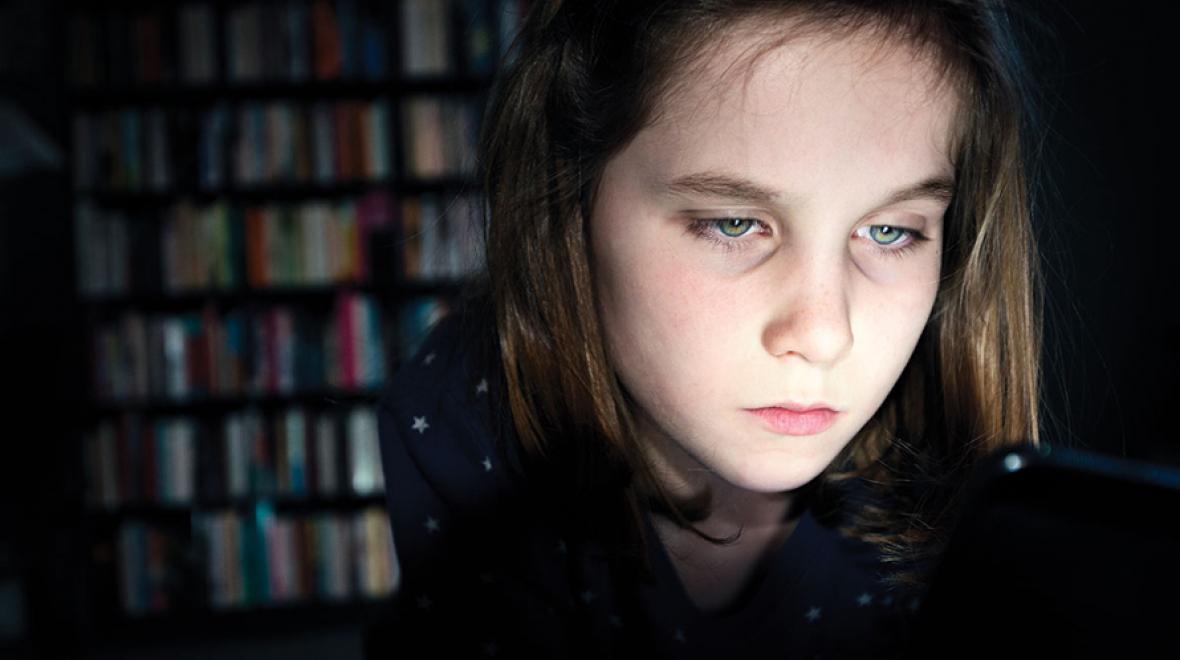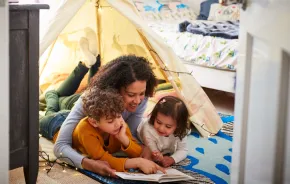
Fifteen-year-old Isaiah Gonzalez was a soon-to-be sophomore preparing to start his Texas school’s ROTC program. Then, in July, his father found him dead in his bedroom closet. Nearby, a propped-up phone broadcast Gonzalez’s suicide online.
Spot the signs
If your teen shows these signs of suicide, call the National Suicide Prevention Lifeline (1-800-273-8255) or your pediatrician.
- Talking about suicide
- Talking about feelings of hopelessness
- Loss of interest in hobbies
- Giving away personal belongings
- Risky, self-destructive or out-of-character behavior
- Preoccupation with death
His parents say their son took part in the Blue Whale Challenge, a macabre social media group promoting a string of challenges that culminate in suicide. Because the challenge is primarily aimed at teens, school districts across the nation have issued warnings about it. The Russian man who says he started the challenge in 2013 pleaded guilty to inciting numerous teen deaths after his arrest last November.
The Blue Whale Challenge is only one example of a recent rash of young people live streaming suicide.
Last December, 12-year-old Katelyn Davis of Georgia livestreamed her suicide on Live.me; the following month, 14-year-old Naika Venant of Florida broadcast her own death. In April, 20-year-old Jamal Chandler of Brooklyn streamed the final minutes of his life before dying by suicide.
In May, police intervened and saved the life of a Georgia teen attempting to broadcast her suicide via Facebook Live. That same month, Facebook cofounder Mark Zuckerberg announced that Facebook would hire 3,000 new employees to screen violent videos — a move some hope will spur more life-saving interventions. Of course, help didn’t come quickly enough for families like Isaiah Gonzalez’s.
What’s happening?
These livestreamed tragedies are the public face of a troubling trend, says Dr. Cora Breuner, an adolescent medicine specialist at Seattle Children’s. According to the Centers for Disease Control and Prevention (CDC), suicide is the second-leading cause of death for teens and young adults ages 15–34. Rates for teens 15–19 are rising fast: Between 2007 and 2015, deaths by suicide increased 31 percent for boys and doubled for girls.
The CDC reports that more than 22 percent of girls and 11 percent of boys seriously considered suicide, and 13 percent had a plan to die. That gender gap in suicide deaths is less about intent and more about the method, says Dr. Christopher Famy, a Seattle psychiatrist who studies suicides. He says males tend to use guns — lethal 85–90 percent of the time when used for suicide — while females tend toward pills — lethal 20 percent of the time.
Between 2007 and 2015, deaths by suicide increased 31 percent for boys and doubled for girls.
What’s driving this steep increase? It’s easy to point to media flashpoints like the buzzy series “13 Reasons Why,” a Netflix drama about the reasons a teenager decided to end her life. But the show and its surrounding hype aren’t to blame, says Breuner; the CDC data is from 2015, two years before the show debuted.
Rather, “13 Reasons Why” and “splashy films like 2016’s “Suicide Squad” and 2011’s “Suicide Room” are more a reflection of a trend than that trend’s driving force, she says. Still, Breuner worries that a glamorized view of mortality can mislead vulnerable, depressed youth into magical thinking about death — namely, that death isn’t truly final. In “13 Reasons Why,” for example, the plot depicts the main character postmortem, yet vibrantly alive.
“In reality, you don’t get to see your friends or anything that happens after you die,” Breuner says. “Once you’re dead, you’re gone, and the show doesn’t make that point.”
Television and movies aside, experts say a more likely culprit for the spike in teen suicides is teens’ increased access to technology. Internet use is linked to suicide rates in the U.S. and worldwide; as rates of internet use increase, so do deaths by suicide. While research shows that news reports of suicide deaths are linked to increased suicide rates, it’s internet use in general that’s linked to more suicides.
That’s troubling news considering that smartphone ownership is up 29 percent since 2011 and that 73 percent of teens own a smartphone, per the Pew Research Center.
Resources you can use
Connect with crisis counselors for free and completely anonymously at the resources below. For all immediate threats of self-harm, call 911 or take your child to the ER.
- Crisis Text Line: Text 741-741 or use Facebook Messenger
- National Suicide Prevention Line: 1-800-273-8255
- Lifeline Crisis Chat
- Suicide intervention for LGBTQ teens
- Suicide intervention for trans youth
To learn about the latest research into suicide, visit:
- Forefront at the University of Washington
- American Association of Suicidology
- Suicide, Guns and Public Health, Harvard School of Public Health
- Society for the Prevention of Teen Suicide (Visit here for a suicide prevention toolkit for high schools).
But why?
The internet gives teens an onramp to pro-suicide websites and chatrooms that give step-by-step instructions for self-harm, says Jennifer Barron, director of training at Forefront, University of Washington’s suicide prevention program.
Even when social media doesn’t point toward suicide — and, of course, not all social media does — it can make it easier for vulnerable teens to feel constantly victimized, says Barron.
“It used to be that kids getting bullied at school could go home and escape,” she says. “Kids who weren’t popular in class could still pal around with kids in their neighborhood and be a different person. Now, there’s no escape.”
Even for kids who seem well-liked, there's pressure from social media that previous generations didn’t have to deal with, says Rosalind Wiseman, author of “Owning Up: Empowering Adolescents to Confront Social Cruelty, Bullying, and Injustice” and founder of Cultures of Dignity, a social justice education and training organization.
“We’ve been telling kids for years that if you make a mistake on social media, you will never get into college, never get a job, [that] your life is over,” Wiseman says. “Especially with kids who have worked hard for things and make a ‘mistake,’ I really worry that they truly believe they have nothing left to live for.”
She points to the suicide of Marcus Wheeler. Arizona State University’s second-ranked cross-country runner, Wheeler died by suicide in 2015 after losing his full-ride scholarship for smoking pot. In 2016, fellow athlete Mitchell Warnock died on the same campus after losing his pole-vaulting scholarship for drinking. While neither Wheeler nor Warnock specified that these incidents led to their suicides, Wiseman says they’re clear examples of the kind of pressure kids are under.
Social media fuels the pressure to be perfect, for both boys and girls, Wiseman adds. In social media’s hyperconnected world, each teen lives in a fishbowl, isolated yet constantly on display. Life’s ups and downs seem magnified, and teens can lose perspective.
Plus, social media allows all of this shift in perspective to play out in an environment where teens can be publicly or privately urged toward acts of self-harm, often out of a parent’s view.
That means kids can spiral deep into suicidal thoughts, actions and even pacts without parents having a clue, says Barron. Even when parents know their teen is having self-destructive thoughts, they may not know enough until the teen acts on those thoughts
Olympia mom Lena* wasn’t a stranger to suicide. Her niece died by suicide five years ago and her 16-year-old son was prone to bouts of depression. He’d mentioned suicide when he was angry, but Lena didn’t think he’d map out a plan to die.
Then, in April, she found a noose in her garage just days after her son’s best friend died by suicide. There may have been a pact, Lena says, but she doesn’t know for sure. “My son was angry and depressed, and I was worried, and then his friend died,” she says. “All of their friends have struggled for months. They are depressed; they’re using drugs and alcohol. They have no ambition and they talk about wanting to die before 30.”
She’s scared for her son, but feels powerless to help. “We’ve been dealing with the effects [of the suicide] ever since it happened.” She takes her son’s mentions of suicide at face value now.
What you can do
As cruel as people can be on the internet, the medium also has the power to connect and heal. According to research published in the “American Journal of Public Health,” social media can aid suicide prevention efforts by connecting teens to help, be it to counselors, resources or other forms of support. The Crisis Text Line offers free crisis counseling via Facebook Messenger and apps like My3 connect suicidal youth to support.
The best prevention, though, is analog: Talk to your teen, says Breuner. The stigma around suicide dissipates if you talk about it like any other health issue. Here, too, media can help.
“If your teen is watching ‘13 Reasons,’ watch it with them,” she says. “Don’t binge-watch. A megadose of a death-themed programming is too intense to digest in one sitting. Instead, use every episode to start a dialogue. Ask how [the main character] could have reached out for help [and] how the other characters could have handled things differently.”
Teens may not suffer a long discussion about suicide, so get to the point. Ask direct questions about your teen’s inner world. “It’s a myth that direct questions will actually prompt a teen to consider suicide, but it’s a myth I hear it all the time,” Breuner says. Research shows that the most effective questions are simple: Are you depressed? Are you having as much fun now as you used to? “These are the diagnostic questions practitioners use, and they’re what’s proven to work well,” Breuner says.
Use your teen’s answers to guide your next steps, she says. If your teen tells you they’re depressed or if they show signs of social withdrawal, sudden academic trouble, extreme mood swings or self-destructive acts, call the National Suicide Prevention Line (1-800-273-8255) or your pediatrician right away. The bottom line: When your teen mentions suicide, take it seriously.
Though direct communication is best, experts like Barron also recommend staying in touch with your child’s life on social media. Have regular conversations about digital citizenship, check social posts regularly and restrict smartphone use at night. Some caregivers might consider apps that help track kids’ social media use, such as Limitly, PocketGuardian and Bark, particularly for younger teens who are just learning to navigate social media. For the most part, these tracking apps don’t give caregivers access to what’s been posted, but instead provide alerts when kids are using or exchanging violent or sexual content. This way, you can intervene before your teen gets swept away by destructive social riptides, says Barron.
A personal experience with suicide: Read one mom's story.
Finally, parents should lock up any guns they may own, says Breuner. “We know that rates of gun ownership are linked to suicide deaths, and that kids are highly impulsive,” she says. “A loaded gun might end a life before a teen can even think about what he’s doing so consider storing your unloaded guns in a biometric safe, keeping the keys or combination secret and storing ammunition separate from any weapons.”
Suicide is rarely about wanting to die, Barron reminds us. It's a sentiment echoed by the parents of Isaiah Gonzalez’s parents. They say their son never wanted to die; rather, his death was the result of social media gone terribly wrong. And live streaming that death? It may have been the final cry for help.
*Name has been changed.
4 myths about suicide
|











